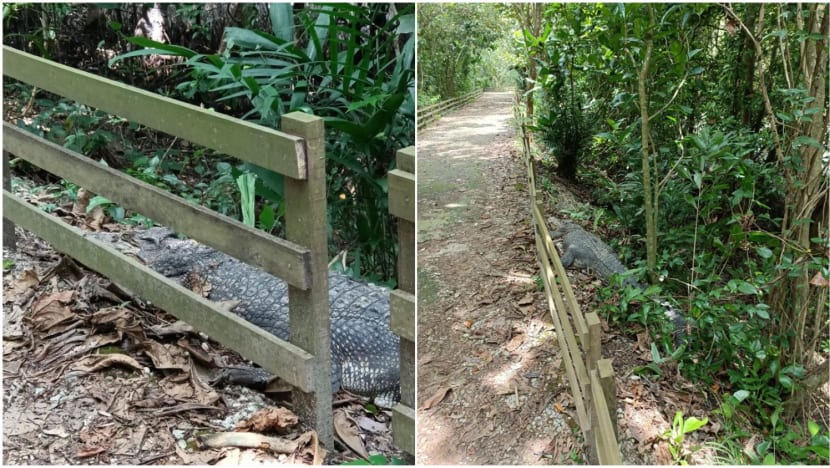Crocodile seen near walking path in Sungei Buloh Wetland Reserve, NParks advises public to keep a distance
The National Parks Board said that it received a report of the crocodile on Sep 30 and that its staff visited the site to check and monitor the situation.

A crocodile seen along a hiking trail in Sungei Buloh Wetland Reserve on Sep 30. (Photos: Matthew Kwa)
SINGAPORE: A man who was trekking in Sungei Buloh Wetland Reserve was shocked to see a crocodile resting just beside the foot trail he was on last Friday (Sep 30) afternoon.
The only thing that had separated Mr Matthew Kwa from the saltwater crocodile, which he estimated to be about 3m to 4m in length, was a wooden fence that the National Parks Board (NParks) had extended in 2018 precisely to keep the reptiles from climbing onto pathways.
“It stayed there motionless for the entire time. I spotted it while trekking and happened to notice it,” said Mr Kwa, who encountered the reptile at about 1.20pm.
According to Mr Kwa, the crocodile was near observation Hide 1C, a shelter along the trail he was on.
Mr Kwa, who works in the IT industry, took out his phone to snap some pictures. He posted the photos on Facebook group Singapore Wildlife Sightings, where it has since garnered more than 1,000 reactions.
“The only time when I read about crocs near the trail was before they build the fence and crocs could easily cross over the trail. Anyone would feel stunned encountering it up close,” he said.
"(I) kept an eye on it while moving forward because nobody could be 100 per cent sure the fence would be able to stop the crocodile."

Responding to CNA’s queries about the crocodile sighting, NParks Group Director of Conservation, Lim Liang Jim said that NParks received a report that an Estuarine Crocodile was sighted behind the fence of a path at Sungei Buloh Wetland Reserve on Sep 30.
“NParks staff visited the site to check on the sighting, remained on-site to monitor the situation, and advised members of the public to keep a distance,” Mr Lim said.
“NParks staff actively patrol during the high tide, where crocodiles are often seen on land. The path is segregated by a fence which acts as a deterrence for crocodiles who might come up to the foot path to bask, move between waterbodies or rest during high tide. Crocodiles, like all wildlife, generally do not attack unless they are provoked."
He added that such crocodiles occur naturally in the wild in Singapore. They feed and rest in brackish and freshwater areas and are usually found in the water or on mudflats away from visitor routes. The crocodiles hunt mainly at night and feed mostly on fish. The cold-blooded creatures rely on external sources of heat, such as the sun, to warm up and hence usually come onto land to bask in the sun.
According to the NParks' website, the Estuarine Crocodile, also known as the Saltwater Crocodile, is one of the largest crocodile species in the world and can grow to more than 5m in length.
It has a long snout and a broad, muscular tail with ridges. While crocodiles may appear bulky and clumsy, they can move very quickly over short distances, both on land and in water. They can become aggressive and attack, especially when provoked, whether on land or in water.
Mr Lim said that in event of a crocodile encounter, members of the public should remain calm and stay a good distance away from the animal, and not approach, provoke or feed it.
“Warning signs and advisory notices have been posted at areas where these animals are most often seen.
"Visitors should heed these signs, which advise the public to stay on the visitor routes and not venture off the designated paths.”
Crocodiles have been spotted in various parts of the reserve over the years.
In 2018, a 2m-long crocodile was spotted by visitors in the middle of a pathway, according to a report by the Straits Times. Visitors had to wait for up to half an hour before the reptile made its way into the bushes.
The crocodile sightings prompted NParks to extend a barricade along the pathway to prevent the crocodiles from climbing onto trails. NParks said then that it would set up a motion-activated camera to monitor the situation.
Responding to CNA queries, the Animal Concerns Research and Education Society (ACRES) said that it has received four to five cases involving crocodiles in the past decade. However these are crocodiles that needed rescue after straying into private property such as golf courses and farms. A spokesperson said that crocodiles often come out of the water to bask and lay eggs.
“Visitorship to our nature reserves have increased in the past few years, most likely due to COVID-19 and travel restrictions. I think that through this, awareness of our local biodiversity has also increased with more people knowing about wildlife which is great news."
"However, as more people visit our parks and reserves, we suggest that first time visitors find out more about the place they are visiting to better prepare themselves. When we enter a nature reserve, we are in nature and awareness of our surroundings are important,” added the ACRES spokesperson.
The spokesperson also advised the public not to bring pets, keep an eye on children and not let them run around, and be vigilant of signs that warn of the wildlife and their crossings. Visitors are also advised to keep food in air-tight containers and hidden in a bag.
The public may also contact NParks’ 24-hour Animal Response Centre at 1800-476-1600 or Sungei Buloh Wetland Reserve at 67941401 to report any encounter.
















